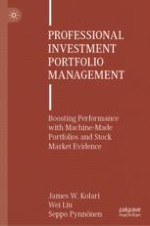It was long believed that well-known aggregate stock market indexes, such as the S&P 500 index and overall CRSP stock market index, were efficient portfolios. Stock market indexes utilize either equal-weighting or value-weighting of individual stocks in their portfolios. However, Kolari, Liu, and Huang (
A new model of capital asset prices: Theory and evidence, Palgrave Macmillan, Cham, Switzerlnd, 2021) have found that these commonly used stock market indexes are inefficient. More efficient, highly diversified portfolios can be constructed using market stock price information that outperform such market indexes. The key to enhancing diversification is to estimate optimized weights for individual stocks in a portfolio that enables higher returns per unit risk. Tests by the authors using historical series of U.S. stock prices repeatedly demonstrated that commonly used stock market indexes are less efficient than portfolios composed of almost the same stocks. Long-run tests were performed based on stock prices over the past 50 years to verify that the results were robust and could be trusted. According to Markowitz’s (
Journal of Finance 7:77-91, 1952;
Portfolio selection: Efficient diversification of investments, Wiley, New York, NY 1959) Nobel Award winning investment theory, assuming that asset prices fully reflect all available information to investors, no portfolios or individual assets can outperform or lie above the efficient frontier
over extended periods of time. If assets are priced correctly by the market, this inference must hold. For investment horizons longer than three or four years, efficient portfolios developed by the techniques provided in this chapter can provide investors with higher risk-adjusted stock returns than possible from other investment strategies. Our highly diversified portfolios using common stocks are well-suited to institutional investors. For example, pension funds can earn higher returns on long-only stock portfolios, thereby enabling them to better meet the needs of pensioners relying on those returns to help pay retirement costs of living. Not only can efficient stock portfolios boost retirement incomes of pensioners, but mutual funds, hedge funds, insurance companies, securities firms, and other investors can benefit too. Of course, short portfolios can be created using the same optimized weighting methods. As such, long-short investment strategies can be created. In this chapter we build net long portfolios
whose weights sum to one for all stocks. We utilize U.S. stock returns from July 1964 to December 2022 to build efficient portfolios. To build relatively efficient portfolios, optimized weights are created for individual stocks based on estimating the empirical ZCAPM
. Using Chapter
7’s
G portfolio returns and cross-sectional standard deviation of returns
(or market return dispersion)
as factors, we estimate the ZCAPM with one year of daily stock returns. Optimal weights are computed from the ZCAPM, a number of portfolios are formed with different financially engineered levels of risk, and the out-of-sample return performance of all portfolios is computed in the next month. This process is rolled forward one month at a time to construct a series of relatively efficient portfolios that are rebalanced each month. We plot the constructed net long portfolios in mean-variance return
space and compare their performance to the CRSP market index, which is widely regarded as an efficient portfolio. Our results demonstrate that the CRSP index
is oftentimes far from efficient and, as predicted by ZCAPM theory, tends to be located in the vicinity of the axis of symmetry
of the parabola far away from the efficient frontier. Sharpe ratios verify the greater efficiency of ZCAPM
-based portfolios compared to the CRSP index
, especially so for our higher risk net long portfolios. Since most investors cannot consistently outperform general market indexes over periods of three to five years, we conclude that the ZCAPM asset pricing model
is a powerful investment tool. Our investment technology can be used by professional institutional investors to create efficient portfolios that are highly diversified and outperform well-known stock market indexes. Importantly, portfolios can be engineered for different risk levels to coincide with the unique risk preferences of different investors. The ability to control risk is a major advantage of our machine-based ZCAPM portfolios. Managers can match up their investment clients with customized risk levels to meet their needs. Subsequent return performance is consistent with these risk levels—that is, lower (higher) risk will result in lower (higher) long-run returns. In this regard, our investment techniques are intended for long-run investors with three-to-five investment time horizons at a minimum. They are not intended as a short-run trading strategy. A surprising finding in our net long portfolios is the outsized performance of high risk portfolios. There appears to be important information in the tails of the cross-sectional distributions of returns in the market that can be employed to build these high-performing portfolios. We discuss this interesting finding in more detail in forthcoming empirical results. The next section gives background discussion. We then review our empirical methods. Subsequently, we present empirical results for U.S. stock returns. As we will see, the performance of our efficient portfolios is remarkable by any existing standard of measurement.
